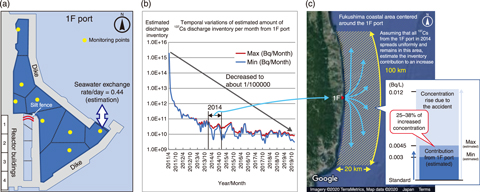
Fig.1-28 (a) Schematic of the Fukushima Daiichi NPS (1F) port, (b) temporal variations of estimated 137Cs discharge per month from the 1F port and (c) 20 km (east–west) and 100 km (north–south) coastal area around the 1F port
Radionuclides (notably, 137Cs) were released into the environment by the accident at the TEPCO’s Fukushima Daiichi NPS (1F). Some rose into the atmosphere and fell on the ground and sea, whereas others were discharged directly into the ocean as contaminated water. Just after the accident, radionuclide concentration of seawater increased near the 1F port due to the direct discharge. However, since the direct discharge was suppressed by the Japanese government and TEPCO, the observed concentrations then decreased rapidly; current concentrations are very low. This work therefore scientifically estimated the amount of 137Cs released from the initial stage of the accident to the present and evaluate the impact on the environment.
As most radionuclides released into the ocean were assumed to be from the 1F port, the amount of 137Cs in the port was focused on. Since the concentration is monitored daily at the eight points shown in Fig.1-28(a), the 1F port was divided into eight areas using the Voronoi tessellation method. The amount of 137Cs in each area was calculated by multiplying the volume of seawater by the observed concentration of 137Cs in each area. When the observed concentration is below the detectable limit, the true concentration is between zero and the detectable limit; therefore, the total amount of 137Cs inside the 1F port (shown in Fig.1-28(a)) was estimated with the interval from zero to the detectable limit. Thus, the daily discharge inventory was estimated by multiplying the estimated total amount in the port and 0.44, which is the seawater exchange rate between the inside and outside of the port. This rate was estimated from the concentration decrease observed in the early stages of the accident. The monthly discharge inventory of 137Cs from the port from April 2011 to March 2020 is shown in Fig.1-28(b). The results indicate that by 2018 the discharge inventory had decreased to approximately 1/100000th of that in the initial stages of the accident.
Assuming that all 137Cs discharged from the port in 2014 spread uniformly and remained in the coastal area surrounding 1F (Fig.1-28(c)), its contribution to the concentration rise was evaluated to be approximately 25% to 38%. However, this is likely to be an overestimate, as 137Cs is spread further than this area. This indicates a greater contribution of other sources (such as run-off from rivers) to the increase in the coastal concentration, and a lesser contribution of the 1F port.
(Susumu Yamada)